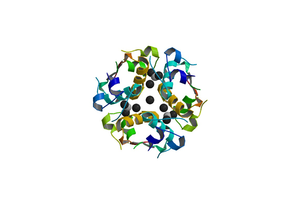Drugs Information:
Insulin lispro
Basic Information

|
||
| ID | DDInter940 | |
| Drug Type | biotech | |
| Protein Chemical Formula | C257H387N65O76S6 | |
| Protein Average Weight | 5808.000 | |
| CAS Number | 133107-64-9 | |
| Description | Insulin lispro is a rapid-acting form of insulin used for the treatment of hyperglycemia caused by Type 1 and Type 2 Diabetes. Insulin is prescribed for the management of diabetes mellitus to mimic the activity of endogenously produced human insulin, a peptide hormone produced by beta cells of the pancreas that promotes glucose metabolism. Insulin is released from the pancreas following a meal to promote the uptake of glucose from the blood into internal organs and tissues such as the liver, fat cells, and skeletal muscle. Absorption of glucose into cells allows for its transformation into glycogen or fat for storage. Insulin also inhibits hepatic glucose production, enhances protein synthesis, and inhibits lipolysis and proteolysis among many other functions. Insulin is an important treatment in the management of Type 1 Diabetes (T1D) which is caused by an autoimmune reaction that destroys the beta cells of the pancreas, resulting in the body not being able to produce the insulin needed to manage circulating blood sugar levels. As a result, people with T1D rely primarily on exogenous forms of insulin, such as insulin lispro, to lower glucose levels in the blood. Insulin is also used in the treatment of Type 2 Diabetes (T2D), another form of diabetes mellitus that is a slowly progressing metabolic disorder caused by a combination of genetic and lifestyle factors that promote chronically elevated blood sugar levels. Without treatment or improvement in non-pharmacological measures such as diet and exercise to lower blood glucose, high blood sugar eventually cause cellular resistance to endogenous insulin, and in the long term, damage to pancreatic islet cells. Insulin is typically prescribed later in the course of T2D, after several oral medications such as [DB00331], [DB01120], or [DB01261] have been tried, and when sufficient damage has been caused to pancreatic cells that the body is no longer able to produce insulin on its own. Marketed as the brand name product Humalog, insulin lispro begins to exert its effects within 15 minutes of subcutaneous administration, while peak levels occur 30 to 90 minutes after administration. Due to its duration of action of around 5 hours, Humalog is considered "bolus insulin" as it provides high levels of insulin in a short period of time to mimic the release of endogenous insulin from the pancreas after meals. Bolus insulin is often combined with once daily, long-acting "basal insulin" such as [DB01307], [DB09564], or [DB00047] to provide low concentrations of background insulin that can keep blood sugar stable between meals or overnight. Use of basal and bolus insulin together is intended to mimic the pancreas' production of endogenous insulin, with a goal of avoiding any periods of hypoglycemia. Insulin lispro is produced by recombinant DNA technology utilizing a non-pathogenic laboratory strain of Escherichia coli and was the first commercially available insulin analog. Formerly called LYSPRO from the chemical nomenclature [LYS(B28), PRO(B29)], insulin lispro differs from human insulin in that the amino acid proline at position B28 is replaced by lysine and the lysine in position B29 is replaced by proline. These biochemical changes result in a reduced tendency for self-association resulting in dissolution to a dimer and then to a monomer that is absorbed more rapidly after subcutaneous injection compared to endogenous human insulin. Without an adequate supply of insulin to promote absorption of glucose from the bloodstream, blood sugar levels can climb to dangerously high levels and can result in symptoms such as fatigue, headache, blurred vision, and increased thirst. If left untreated, the body starts to break down fat, instead of glucose, for energy which results in a build-up of ketone acids in the blood and a syndrome called ketoacidosis, which is a life-threatening medical emergency. In the long term, elevated blood sugar levels increase the risk of heart attack, stroke, and diabetic neuropathy. | |
| ATC Classification | A10AC04 A10AB04 A10AD04 | |
| Sequences | >A chain GIVEQCCTSICSLYQLENYCN | |
| Useful Links | DrugBank PubChem Substance KEGG Drug PharmGKB Therapeutic Targets Database Wikipedia ChEMBL | |
Interactions with
Insulin lispro
Filter:
| Severity level | ID | Name | Mechanism | Detail |
|---|
Interactions with diseases
Filter:
| Severity level | Disease name | Text | References |
|---|
Interactions with foods
Filter:
| Severity level | Food name | Description | Management | Mechanism | References |
|---|
Interactions with compound preparation
| Multi-DRUG trade | Multi-DRUG | Drug type | Warning | Note |
|---|